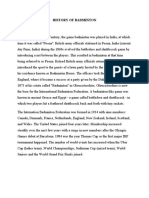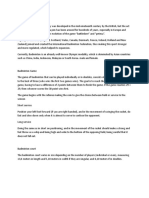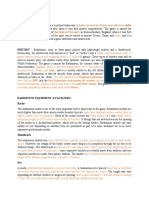Badminton
Badminton
Uploaded by
api-238998742Original Title
Copyright
Available Formats
Share this document
Did you find this document useful?
Is this content inappropriate?
Report this DocumentCopyright:
Available Formats
Badminton
Badminton
Uploaded by
api-238998742Copyright:
Available Formats
A brief look at the history and background of badminton
Badminton
is a racquet sport played by either two opposing players (singles) or two opposing pairs (doubles), who take positions on opposite halves of a rectangular court divided by a net.
mid-1800s in British India - created by British military officers stationed there. Early photographs show Englishmen adding a net to the traditional English game of battledore and shuttlecock. Being particularly popular in the British garrison town Poona (now Pune), the game also came to be known as Poona.
The
International Badminton Federation (IBF) (now known as Badminton World Federation) was established in 1934 with Canada, Denmark, England, France, the Netherlands, Ireland, New Zealand, Scotland, and Wales as its founding members. India joined as an affiliate in 1936. The BWF now governs
The full width of the court is 6.1 metres (20 ft) and in singles this width is reduced to 5.18 metres (17 ft). The full length of the court is 13.4 metres (44 ft). by a short service line at a distance of 1.98 metres (6 ft 6 inch) from the net, and by the outer side and back boundaries. In doubles, the service court is also marked by a long service line, which is
The
net is 1.55 metres (5 ft 1 inch) high at the edges and 1.524 metres (5 ft) high in the centre. The net posts are placed over the doubles sidelines, even when singles is played.
3.1
To test a shuttlecock, use a full underhand stroke which makes contact with the shuttlecock over the back boundary line. The shuttlecock shall be hit at an upward angle and in a direction parallel to the side lines. 3.2 A shuttlecock of the correct speed will land not less than 530 mm and not more than 990 mm short of the
At
the start of the rally, the server and receiver stand in diagonally opposite service courts The server hits the shuttlecock so that it would land in the receiver's service court. This is similar to tennis. In singles, the server stands in their right service court when their score is even, and in her/his left service court
In
doubles, if the serving side wins a rally, the same player continues to serve, but he/she changes service courts so that she/he serves to a different opponent each time. If the opponents win the rally and their new score is even, the player in the right service court serves; if odd, the player in the left service
When the server serves, the shuttlecock must pass over the short service line on the opponents' court or it will count as a fault. If the score reaches 20-all, then the game continues until one side gains a two point lead (such as 2422), up to a maximum of 30 points (3029 is a winning score). At the start of a match, the shuttlecock is cast and the side towards which the shuttlecock is pointing serves first. Alternatively, a coin may be tossed, with the winners choosing whether to serve or receive first, or choosing which end of
a let is called, the rally is stopped and replayed with no change to the score. Lets may occur because of some unexpected disturbance such as a shuttlecock landing on court (having been hit there by players on an adjacent court) or in small halls the shuttle
Raquets Badminton racquets are lightweight, with top quality racquets weighing between 70 and 95 grams (2.4 to 3.3 ounces) not including grip or strings. They are composed of many different materials ranging from carbon fibre composite (graphite reinforced plastic) to solid steel.
Badminton
strings are thin, high performing strings in the range of about 0.62 to 0.73 mm thickness Recreational players generally string at lower tensions than professionals, typically between 80 and 110 N (18 and
There are two main types of grip: replacement grips and overgrips: Replacement grips are thicker, and are often used to increase the size of the handle. Overgrips are thinner (less than 1 mm), and are often used as the final layer Towelling grips are always
A shuttlecock (often abbreviated to shuttle; also called a birdie) is a highdrag projectile, with an open conical shape: the cone is formed from sixteen overlapping feathers embedded into a rounded cork base. The cork is covered with thin leather or synthetic material. Synthetic shuttles are often used by recreational players to reduce their costs as feathered shuttles break easily. These nylon shuttles may be constructed with
Badminton
shoes are lightweight with soles of rubber or similar high-grip, non-marking materials. Compared to running shoes, badminton shoes have little lateral support. High levels of lateral support are useful for activities where lateral motion is undesirable and unexpected. Badminton, however,
Forehand and Backhand Badminton offers a wide variety of basic strokes, and players require a high level of skill to perform all of them effectively. All strokes can be played either forehand or backhand. A player's forehand side is the same side as their playing hand: for a right-handed player, the forehand side is their right side and the backhand side is their left side. Forehand strokes are hit with the front of the hand leading (like hitting with the palm), whereas backhand strokes are hit with the back of the hand leading (like hitting with the
You might also like
- BadmintonDocument51 pagesBadmintonVicky Singh100% (1)
- NCSU All-Girl Cheer Sponsorship LetterDocument1 pageNCSU All-Girl Cheer Sponsorship LetterLaura Leigh Benfield BrittainNoch keine Bewertungen
- Beijing National StadiumDocument8 pagesBeijing National StadiumMuhammad Khofidul QolbiNoch keine Bewertungen
- A Badminton DaveDocument4 pagesA Badminton DaveRofher Jick Delos SantosNoch keine Bewertungen
- PEH BadmintonDocument15 pagesPEH BadmintonAislinn Sheen AcasioNoch keine Bewertungen
- BADMINTONDocument18 pagesBADMINTONHumanNoch keine Bewertungen
- BadmintonDocument7 pagesBadmintonSherin SethiNoch keine Bewertungen
- History of BadmintonDocument3 pagesHistory of BadmintonAcbel RnucoNoch keine Bewertungen
- History: Badminton Is A Racquet Sport Played Using Racquets To Hit A Shuttlecock Across A Net. AlthoughDocument5 pagesHistory: Badminton Is A Racquet Sport Played Using Racquets To Hit A Shuttlecock Across A Net. AlthoughSunshine KhuletzNoch keine Bewertungen
- Badminton Content 1Document11 pagesBadminton Content 1mnica4962Noch keine Bewertungen
- Badminton 1Document7 pagesBadminton 1Marley AchuyNoch keine Bewertungen
- P.E.research AvtivityDocument5 pagesP.E.research AvtivityLander Fontanilla BorelaNoch keine Bewertungen
- Badminton: History and DevelopmentDocument6 pagesBadminton: History and DevelopmentGanesh KaleNoch keine Bewertungen
- Badminton I: A New Game, But Unfortunately No Copy Has SurvivedDocument13 pagesBadminton I: A New Game, But Unfortunately No Copy Has SurvivedKatie JusayNoch keine Bewertungen
- BadmintonDocument6 pagesBadmintonVishesh TyagiNoch keine Bewertungen
- Pe Mo Liu StuffDocument4 pagesPe Mo Liu StuffhatemalkyNoch keine Bewertungen
- BadmintonDocument12 pagesBadmintonvasundhra.altNoch keine Bewertungen
- Badminton Is A Racquet Sport Played by Either Two Opposing Players (Singles) or Two OpposingDocument5 pagesBadminton Is A Racquet Sport Played by Either Two Opposing Players (Singles) or Two OpposingKatrina Clarisse HutallaNoch keine Bewertungen
- BADMINTON Peh Dual SharikaDocument4 pagesBADMINTON Peh Dual SharikaBernadeth BaiganNoch keine Bewertungen
- Badminton: History and DevelopmentDocument15 pagesBadminton: History and Developmentnitin_123abcNoch keine Bewertungen
- PE Assignment1Document7 pagesPE Assignment1Diana MaeNoch keine Bewertungen
- Badminton: History and DevelopmentDocument16 pagesBadminton: History and DevelopmentsarojpapuNoch keine Bewertungen
- History and Development: Badminton Is A Racquet Sport Played by Either Two Opposing Players (Singles) or Two OpposingDocument7 pagesHistory and Development: Badminton Is A Racquet Sport Played by Either Two Opposing Players (Singles) or Two OpposingbrycadsNoch keine Bewertungen
- BadmintonDocument12 pagesBadmintonjerrickoiNoch keine Bewertungen
- Geogrfi 2Document26 pagesGeogrfi 2Shivesh RauNoch keine Bewertungen
- Badminton: Racquet Sport ShuttlecockDocument18 pagesBadminton: Racquet Sport ShuttlecockJnanadarshan NayakNoch keine Bewertungen
- BadmintonDocument4 pagesBadmintonTine ZantuaNoch keine Bewertungen
- Scoring and Equiments in BadmintonDocument3 pagesScoring and Equiments in BadmintonRonaldNoch keine Bewertungen
- History of BadmintonDocument3 pagesHistory of BadmintonJones PadicaNoch keine Bewertungen
- Badminton Is A: Racquet Sport ShuttlecockDocument10 pagesBadminton Is A: Racquet Sport ShuttlecockRapha RachoNoch keine Bewertungen
- Badminton ScrapbookDocument12 pagesBadminton ScrapbookIlakiya Ilakiya100% (1)
- Prelim Reviewer PE 2Document16 pagesPrelim Reviewer PE 2cynangelaNoch keine Bewertungen
- Pe WordDocument13 pagesPe WordTejas AmbekarNoch keine Bewertungen
- BADMINTONDocument5 pagesBADMINTONDenice VicenteNoch keine Bewertungen
- History and Development: Badminton Is A Racquet Sport Played by Either Two Opposing Players (Singles) or TwoDocument8 pagesHistory and Development: Badminton Is A Racquet Sport Played by Either Two Opposing Players (Singles) or TwoChristian PalconNoch keine Bewertungen
- Badminton-My Favourite SportDocument10 pagesBadminton-My Favourite SportRRCNoch keine Bewertungen
- Badminton LessonsDocument9 pagesBadminton LessonsCamille MaterumNoch keine Bewertungen
- BadmintonDocument58 pagesBadmintonMakmak Fernandez100% (1)
- UkitnamDocument4 pagesUkitnamNina NathaliaNoch keine Bewertungen
- BadmintonDocument6 pagesBadmintonJohnferson S. BornalesNoch keine Bewertungen
- History of BadmintonDocument7 pagesHistory of BadmintonDwindylou MarinasNoch keine Bewertungen
- Badminton and Table TennisDocument5 pagesBadminton and Table TennisKris Tin100% (1)
- History and Development: Racquet Sport ShuttlecockDocument20 pagesHistory and Development: Racquet Sport ShuttlecockPramodSharma100% (1)
- A Brief History of BadmintonDocument12 pagesA Brief History of BadmintonRonel FillomenaNoch keine Bewertungen
- BadmintonDocument9 pagesBadmintonRon Jorel B. LibunaoNoch keine Bewertungen
- BadmintonDocument10 pagesBadmintonAmzel PaguioNoch keine Bewertungen
- Badminton: History and DevelopmentDocument9 pagesBadminton: History and DevelopmentJanine Kyra RiveraNoch keine Bewertungen
- BadmintonDocument20 pagesBadmintonJerrica Mae GalvezNoch keine Bewertungen
- BADMINTONDocument69 pagesBADMINTONalvinbelerbelchez17Noch keine Bewertungen
- Racquet Sport: History and DevelopmentDocument7 pagesRacquet Sport: History and DevelopmentPro FessorTanNoch keine Bewertungen
- Badminton: INVENTORY - Badminton As It Is Played Today WasDocument4 pagesBadminton: INVENTORY - Badminton As It Is Played Today WasJanna Mae GranadaNoch keine Bewertungen
- Badminton Study Guide-CentralDocument4 pagesBadminton Study Guide-CentralLeonimar S BernidoNoch keine Bewertungen
- EinführungDocument32 pagesEinführungmarudi_princess4753Noch keine Bewertungen
- History of BadmintonDocument4 pagesHistory of BadmintonVoltaire M. BernalNoch keine Bewertungen
- Reporting About BadmintonDocument20 pagesReporting About Badmintonexonmonstere100% (2)
- Presentation in BadmintonDocument68 pagesPresentation in BadmintonJohn Paul Espiña CandoNoch keine Bewertungen
- PE3 History of BadmintonDocument7 pagesPE3 History of BadmintonKreviazuk316100% (2)
- Badminton Sport: Submitted By: Manav Lakdawala Institution:l.p Savani International SchoolDocument35 pagesBadminton Sport: Submitted By: Manav Lakdawala Institution:l.p Savani International SchoolManav LakdawalaNoch keine Bewertungen
- BadmintonDocument24 pagesBadmintondaniel.angelesNoch keine Bewertungen
- Indoor Recreational Activities: Group 1Document27 pagesIndoor Recreational Activities: Group 1LYRAH JEAN CAGAYANNoch keine Bewertungen
- Fina Swimming Rules 2005 - 2009Document27 pagesFina Swimming Rules 2005 - 2009Hong Kong SwimmingNoch keine Bewertungen
- Velocity ProblemsDocument4 pagesVelocity ProblemshevelascoNoch keine Bewertungen
- Wellesley Weekly 29/06/2015Document1 pageWellesley Weekly 29/06/2015Wellesley HouseNoch keine Bewertungen
- Sports LanguageDocument5 pagesSports LanguageJaylanie EvangelistaNoch keine Bewertungen
- Cabin Fever 2012Document2 pagesCabin Fever 2012track6306Noch keine Bewertungen
- Surf Team CoachingDocument9 pagesSurf Team CoachingwillntwetNoch keine Bewertungen
- 201007Document49 pages201007aguadojorgeNoch keine Bewertungen
- FINA Brand Guidelines ShortDocument67 pagesFINA Brand Guidelines ShortDamianNoch keine Bewertungen
- Competition Schedule 092020 Chengdu 2021Document2 pagesCompetition Schedule 092020 Chengdu 2021BerichtNoch keine Bewertungen
- Open Water Rescue Scenario One Overview: Distressed Diver Underwater With Extremity InjuryDocument10 pagesOpen Water Rescue Scenario One Overview: Distressed Diver Underwater With Extremity InjuryBebe MatiiNoch keine Bewertungen
- (1922) Handbook of The Amateur Athletic UnionDocument170 pages(1922) Handbook of The Amateur Athletic UnionHerbert Hillary Booker 2ndNoch keine Bewertungen
- Rio-2016 Questions PDFDocument3 pagesRio-2016 Questions PDFKESHAB BHOINoch keine Bewertungen
- Dhyan Chand AwardDocument3 pagesDhyan Chand AwardJayaraj BalachandranNoch keine Bewertungen
- Questões de Ingles - SSADocument2 pagesQuestões de Ingles - SSAJailson SiqueiraNoch keine Bewertungen
- Kamiak Boys Win Wesco 4A District Swimming TitleDocument6 pagesKamiak Boys Win Wesco 4A District Swimming TitlestprepsNoch keine Bewertungen
- Disqualification Codes 2014 - 2017Document2 pagesDisqualification Codes 2014 - 2017myline aneculNoch keine Bewertungen
- Informative Speech OutlineDocument4 pagesInformative Speech Outlineapi-242647627Noch keine Bewertungen
- Aymestrey Magazine 1989Document24 pagesAymestrey Magazine 1989Des KnoxNoch keine Bewertungen
- New Acting Resume PDFDocument1 pageNew Acting Resume PDFAnonymous 7yDIIjo5ONoch keine Bewertungen
- Sport On The Barcoo: Four Walk Away From CrashDocument10 pagesSport On The Barcoo: Four Walk Away From CrashbarcooindependentNoch keine Bewertungen
- SwimmingDocument2 pagesSwimmingFàïth GèsïmNoch keine Bewertungen
- Mtt30 MG Final 2015Document20 pagesMtt30 MG Final 2015newspubincNoch keine Bewertungen
- Research Paper in Basic SwimmingDocument17 pagesResearch Paper in Basic Swimminglrac_adazol0% (2)
- Peak Performance BuoyancyDocument2 pagesPeak Performance BuoyancyKelly BoalNoch keine Bewertungen
- Handball Oral ReportDocument3 pagesHandball Oral ReportMatixFabianSolisManriquezNoch keine Bewertungen
- English For KidsDocument9 pagesEnglish For KidsAmanda TaylorNoch keine Bewertungen
- Palace of Water Sports in KazanDocument13 pagesPalace of Water Sports in KazanAzel Mica Garcia0% (1)
























































































